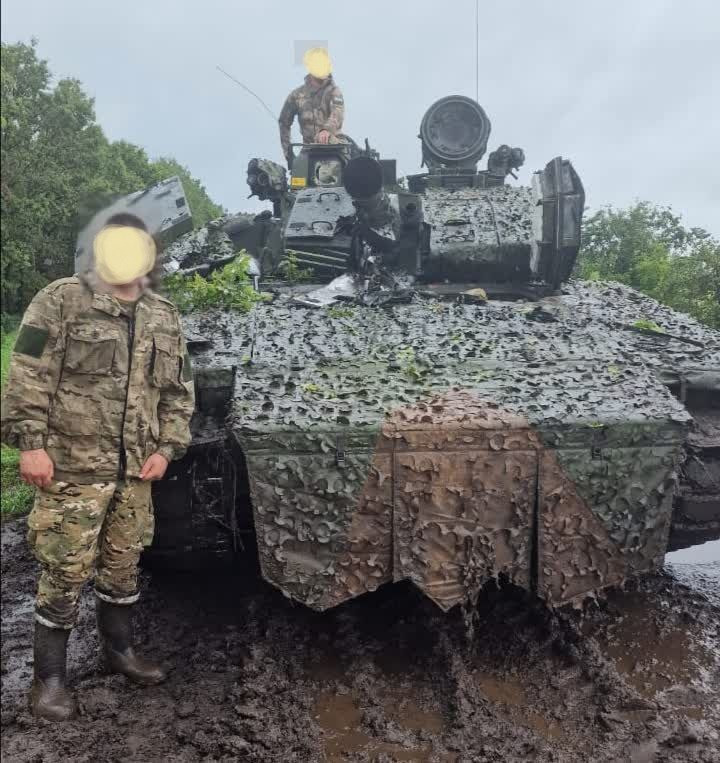Ukraine has lost the first of its advanced and sophisticated Swedish CV9040C Infantry Fighting Vehicles (IFV) near Kreminna in Luhansk in the country’s east to Russian rocket fire.
VIDEO: Russian troops examining a disabled and abandoned ex-Swedish Ukrainian CV90 that was reportedly hit by a Russian RPG near Kreminna recently.#Russia #Ukraine #CV90 #armored #swedish #UkraineRussiaWar pic.twitter.com/244sD0kbie
— EurAsian Times (@THEEURASIATIMES) July 31, 2023
Videos and subsequent photos on social media show Russian servicemen standing in front of the vehicle, indicating it had been captured and would now be studied for technological espionage and reverse engineering purposes.
The CV90 is a part of the Ukrainian army’s unique 21st Mechanized Brigade. It owns nearly all Swedish land systems, including around 50 CV90s, 10 Stridsvagn 122 (Swedish designation for the Leopard 2A5), and eight Archer truck-mounted self-propelled howitzers (SPH), according to a report in Kyiv Post that quoted war monitoring site Oryx.
Also called the Stridsforon 90 and considered one of the best IFVs in the world, the 37-ton vehicle has a 40mm Bofors L70 main gun and can carry nine troops into the battlefield.
The IFV’s arrival in Ukraine was announced by Ukrainian defense minister Oleksii Reznikov on July 8, showing six of the CV90s spread out in a small staging area, with the crew on top of them.
As part of the ongoing Ukrainian counteroffensive, the action has seen several dozen Western tanks and armored vehicles being destroyed in Russian minefields, artillery fire, and anti-tank helicopter gunship fire from Ka-52 Alligator choppers.
With only local actions and counterattacks successful against Russian forces, there still do not seem to be any major breakthroughs into Russian defense lines.
Video Shows CV90 Being Hit
The video, which surfaced between Saturday and Sunday, showed two IFVs, one of them was the target CV90 in the front, rolling down along a tree line.
The one in the front is struck by the RPG 50 to 100 feet away, causing it to veer off-road while the one behind comes to a halt. It, too, is nearly hit by a rocket that lands on the ground just ahead of it. It is not clear if the other IFV too is a CV90.
Many Twitter posts claimed the vehicle was captured by the Russian army. A few Telegram channels identified the Russian unit as the 252nd Motorized Rifle Regiment of the 3rd Motorized Rifle Division in the Chervonopopovka area near Starobelsk.
The commander was also killed, as per another Telegram post, but this claim could not be independently verified.
“They deliberately waited for two CV90s in a specific place and ambushed them,” said the post on the Telegram channel of RIA Novosti military correspondents Alexander Kharchenko and Sergey Shilov.

It means that the Russians lured the Ukrainians into the area with a local counterattack, forcing the former to send in ground assets to repel the assault. But the actual aim was to destroy some of the Western equipment, for which the RPG team must have been lying in wait, neatly camouflaged.
This is consistent with the Russian practice of using artillery, shoulder-fired rockets, or aerial strikes to destroy enemy armor while using their own armor for fire support and infantry cover. Tanks and armor are not usually used for ‘breakthrough’ roles.
Captured & To Be Taken Apart
A clip from the same channel showed the abandoned and disabled vehicle being examined from the outside and inside. It showed a hit to the front right side under the turret, with a small piercing hole, meaning the High-Explosive Anti-Tank (HEAT) round got through.
However, it is unclear if this video was shot at the exact location where the RPG struck the vehicle or after it was driven or towed behind Russian lines. It may be the latter since the Ukrainians are unlikely to give up an opportunity to attack Russian troops gathered at a location, possibly using kamikaze drones or artillery.
Russian engineers would likely strip apart the vehicle’s electronics and various circuit boards of its targeting and fire-control system, the electro-optical sights and engine, and the Bofors gun.
Russia is in a massive effort to increase domestic manufacturing of microelectronics and computer circuitry, an area it has traditionally lagged in and depended on Western imports, now under sanctions.
- The author can be reached at satamp@gmail.com
- Follow EurAsian Times on Google News




